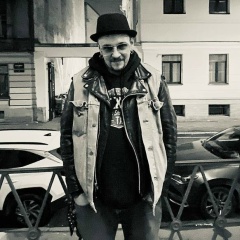Вот такой оказывается история, когда её очищают от придуманных идеологических мифов.
До конца жизни Киров так и оставался именно ленинградским партийным вождем. Известный историк Олег Хлевнюк верно подметил, что члены Политбюро, управлявшие региональными парторганизациями, - Киров, Чубарь, Косиор, Петровский - занимались своими местными делами и в Москве появлялись эпизодически. И не был Киров ни "виднейшим соратником Сталина", как стали писать после гибели, ни лидером некоей мифической оппозиции на XVII съезде партии, о чем без реальных доказательств заговорили при Хрущеве, пытаясь выдать за реальность лихую частушку о том, как "Сталин Кирова убил в темном коридорчике". Часто важные решения, принимавшиеся опросом членов Политбюро, вообще обходились без подписи Сергея Мироновича - в большие кремлевские проблемы он по возможности старался не вмешиваться. Благоволивший ему Сталин на том самом XVII съезде в начале 1934-го попытался было перетащить его в Москву, но в итоге краткого рабочего конфликта вождей Киров настоял на своем и, получив новый пост секретаря ЦК, остался в Ленинграде выполнять планы второй пятилетки. Из Горького в Москву для исполнения намеченных для Кирова обязанностей пришлось срочно переводить Жданова.
Итак, "Великий гражданин", как назывался фильм Фридриха Эрмлера по мотивам биографии Кирова, появившийся в конце 1930-х, в реальной жизни излишним политическим весом не обладал. Трагедия 1 декабря 1934 года в Смольном стала возможна не в результате чьего-либо заговора, а по стечению двух главных обстоятельств - вопиющих недостатков охраны здания и порывистого характера самого Кирова.
До 1932 года вход в Смольный вообще был свободным, без каких-либо пропусков, а к декабрю 1934-го пропускная система была во многом декоративной. В бывшем институте благородных девиц работали 1829 человек, а благодаря пристройке в помещения обкома и горкома партии могли попасть из соседних корпусов и жители Дома крестьянина, и посетители грозной комиссии по делам лишенцев, и даже работники также смежного со Смольным свинарника для снабжения местных столовых. Особый подъезд для первых лиц Ленинграда охранялся не более строго - там на 1-м этаже умудрились поместить парикмахерскую, посещаемую кем угодно. Для входа на 3-й этаж, где работал Киров, достаточно было предъявить партбилет, а таковой у убийцы Леонида Николаева имелся. Любой попавший в помещения обкома и горкома ВКП(б) в Смольном мог беспрепятственно оказаться в районе кабинета Сергея Мироновича, у входа в его приемную. При такой охране теракт мог совершить не только подготовленный диверсант, но и неопытный мститель-одиночка, каковым и оказался Николаев.
Сам Киров охрану при себе терпел с трудом. Его ежедневный распорядок дня резко отличался от привычек Сталина - по ночам он не работал (максимум до часу ночи), в кабинете в Смольном проводил обычно только полдня, потом ездил на фабрики и заводы. Отметим, что Киров был одним из немногих советских вождей, не нуждавшихся в систематическом лечении и тяготившихся курортным отдыхом. Переехав из солнечного Баку на берега Невы, Сергей Миронович поражал окружающих своей всегдашней бодростью. Как вспоминал один из его спутников по охоте, "сам С.М. был очень здоров. Никогда не простужался, не боялся ни дождей, ни морозов".
До конца жизни Киров так и оставался именно ленинградским партийным вождем. Известный историк Олег Хлевнюк верно подметил, что члены Политбюро, управлявшие региональными парторганизациями, - Киров, Чубарь, Косиор, Петровский - занимались своими местными делами и в Москве появлялись эпизодически. И не был Киров ни "виднейшим соратником Сталина", как стали писать после гибели, ни лидером некоей мифической оппозиции на XVII съезде партии, о чем без реальных доказательств заговорили при Хрущеве, пытаясь выдать за реальность лихую частушку о том, как "Сталин Кирова убил в темном коридорчике". Часто важные решения, принимавшиеся опросом членов Политбюро, вообще обходились без подписи Сергея Мироновича - в большие кремлевские проблемы он по возможности старался не вмешиваться. Благоволивший ему Сталин на том самом XVII съезде в начале 1934-го попытался было перетащить его в Москву, но в итоге краткого рабочего конфликта вождей Киров настоял на своем и, получив новый пост секретаря ЦК, остался в Ленинграде выполнять планы второй пятилетки. Из Горького в Москву для исполнения намеченных для Кирова обязанностей пришлось срочно переводить Жданова.
Итак, "Великий гражданин", как назывался фильм Фридриха Эрмлера по мотивам биографии Кирова, появившийся в конце 1930-х, в реальной жизни излишним политическим весом не обладал. Трагедия 1 декабря 1934 года в Смольном стала возможна не в результате чьего-либо заговора, а по стечению двух главных обстоятельств - вопиющих недостатков охраны здания и порывистого характера самого Кирова.
До 1932 года вход в Смольный вообще был свободным, без каких-либо пропусков, а к декабрю 1934-го пропускная система была во многом декоративной. В бывшем институте благородных девиц работали 1829 человек, а благодаря пристройке в помещения обкома и горкома партии могли попасть из соседних корпусов и жители Дома крестьянина, и посетители грозной комиссии по делам лишенцев, и даже работники также смежного со Смольным свинарника для снабжения местных столовых. Особый подъезд для первых лиц Ленинграда охранялся не более строго - там на 1-м этаже умудрились поместить парикмахерскую, посещаемую кем угодно. Для входа на 3-й этаж, где работал Киров, достаточно было предъявить партбилет, а таковой у убийцы Леонида Николаева имелся. Любой попавший в помещения обкома и горкома ВКП(б) в Смольном мог беспрепятственно оказаться в районе кабинета Сергея Мироновича, у входа в его приемную. При такой охране теракт мог совершить не только подготовленный диверсант, но и неопытный мститель-одиночка, каковым и оказался Николаев.
Сам Киров охрану при себе терпел с трудом. Его ежедневный распорядок дня резко отличался от привычек Сталина - по ночам он не работал (максимум до часу ночи), в кабинете в Смольном проводил обычно только полдня, потом ездил на фабрики и заводы. Отметим, что Киров был одним из немногих советских вождей, не нуждавшихся в систематическом лечении и тяготившихся курортным отдыхом. Переехав из солнечного Баку на берега Невы, Сергей Миронович поражал окружающих своей всегдашней бодростью. Как вспоминал один из его спутников по охоте, "сам С.М. был очень здоров. Никогда не простужался, не боялся ни дождей, ни морозов".
This is how history turns out when it is purged of invented ideological myths.
Until the end of his life, Kirov remained precisely the Leningrad party leader. The well-known historian Oleg Khlevnyuk correctly noted that the members of the Politburo who ruled regional party organizations - Kirov, Chubar, Kosior, Petrovsky - were engaged in their local affairs and appeared in Moscow sporadically. And Kirov was neither "the most prominent associate of Stalin," as they began to write after his death, nor the leader of some mythical opposition at the 17th party congress, which, without real evidence, they started talking under Khrushchev, trying to pass off as reality a dashing ditty about how "Stalin killed Kirov in a dark corridor ". Often, important decisions made by polling members of the Politburo generally did without the signature of Sergei Mironovich - he tried not to interfere in big Kremlin problems as much as possible. Stalin, who favored him, at the same XVII Congress in early 1934 tried to drag him to Moscow, but as a result of a short working conflict between the leaders, Kirov insisted on his own and, having received the new post of Secretary of the Central Committee, remained in Leningrad to fulfill the plans of the second five-year plan. Zhdanov had to be urgently transferred from Gorky to Moscow to fulfill the duties planned for Kirov.
So, "The Great Citizen", as the film by Friedrich Ermler was called based on the biography of Kirov, which appeared in the late 1930s, in real life did not have excessive political weight. The tragedy of December 1, 1934 in Smolny became possible not as a result of someone's conspiracy, but due to the coincidence of two main circumstances - the glaring shortcomings of the building's security and the impetuous nature of Kirov himself.
Until 1932, the entrance to Smolny was generally free, without any passes, and by December 1934, the access system was largely decorative. In the former institute of noble maidens, 1,829 people worked, and thanks to the extension, residents of the Peasant's House, and visitors to the formidable commission on the affairs of the disenfranchised, and even workers of the pigsty also adjacent to Smolny could get into the premises of the regional and city party committee from neighboring buildings to supply local canteens. A special entrance for the first persons of Leningrad was not guarded more strictly - there, on the 1st floor, they managed to place a hairdresser's, visited by anyone. To enter the third floor, where Kirov worked, it was enough to show his party card, and the killer Leonid Nikolaev had one. Anyone who got into the premises of the regional committee and the city committee of the CPSU (b) in Smolny could easily find himself in the area of Sergei Mironovich's office, at the entrance to his reception room. With such protection, a terrorist attack could have been carried out not only by a trained saboteur, but also by an inexperienced lone avenger, which turned out to be Nikolaev.
Kirov himself could hardly bear the security with him. His daily routine was sharply different from Stalin's habits - he did not work at night (until one in the morning at the most), in his office in Smolny he usually spent only half a day, then went to factories and plants. Note that Kirov was one of the few Soviet leaders who did not need systematic treatment and were burdened by resort holidays. Having moved from sunny Baku to the banks of the Neva, Sergei Mironovich amazed those around him with his everlasting cheerfulness. As one of his hunting companions recalled, "SM himself was very healthy. He never caught a cold, was not afraid of rain or frost."
Until the end of his life, Kirov remained precisely the Leningrad party leader. The well-known historian Oleg Khlevnyuk correctly noted that the members of the Politburo who ruled regional party organizations - Kirov, Chubar, Kosior, Petrovsky - were engaged in their local affairs and appeared in Moscow sporadically. And Kirov was neither "the most prominent associate of Stalin," as they began to write after his death, nor the leader of some mythical opposition at the 17th party congress, which, without real evidence, they started talking under Khrushchev, trying to pass off as reality a dashing ditty about how "Stalin killed Kirov in a dark corridor ". Often, important decisions made by polling members of the Politburo generally did without the signature of Sergei Mironovich - he tried not to interfere in big Kremlin problems as much as possible. Stalin, who favored him, at the same XVII Congress in early 1934 tried to drag him to Moscow, but as a result of a short working conflict between the leaders, Kirov insisted on his own and, having received the new post of Secretary of the Central Committee, remained in Leningrad to fulfill the plans of the second five-year plan. Zhdanov had to be urgently transferred from Gorky to Moscow to fulfill the duties planned for Kirov.
So, "The Great Citizen", as the film by Friedrich Ermler was called based on the biography of Kirov, which appeared in the late 1930s, in real life did not have excessive political weight. The tragedy of December 1, 1934 in Smolny became possible not as a result of someone's conspiracy, but due to the coincidence of two main circumstances - the glaring shortcomings of the building's security and the impetuous nature of Kirov himself.
Until 1932, the entrance to Smolny was generally free, without any passes, and by December 1934, the access system was largely decorative. In the former institute of noble maidens, 1,829 people worked, and thanks to the extension, residents of the Peasant's House, and visitors to the formidable commission on the affairs of the disenfranchised, and even workers of the pigsty also adjacent to Smolny could get into the premises of the regional and city party committee from neighboring buildings to supply local canteens. A special entrance for the first persons of Leningrad was not guarded more strictly - there, on the 1st floor, they managed to place a hairdresser's, visited by anyone. To enter the third floor, where Kirov worked, it was enough to show his party card, and the killer Leonid Nikolaev had one. Anyone who got into the premises of the regional committee and the city committee of the CPSU (b) in Smolny could easily find himself in the area of Sergei Mironovich's office, at the entrance to his reception room. With such protection, a terrorist attack could have been carried out not only by a trained saboteur, but also by an inexperienced lone avenger, which turned out to be Nikolaev.
Kirov himself could hardly bear the security with him. His daily routine was sharply different from Stalin's habits - he did not work at night (until one in the morning at the most), in his office in Smolny he usually spent only half a day, then went to factories and plants. Note that Kirov was one of the few Soviet leaders who did not need systematic treatment and were burdened by resort holidays. Having moved from sunny Baku to the banks of the Neva, Sergei Mironovich amazed those around him with his everlasting cheerfulness. As one of his hunting companions recalled, "SM himself was very healthy. He never caught a cold, was not afraid of rain or frost."
У записи 12 лайков,
10 репостов.
10 репостов.
Эту запись оставил(а) на своей стене Максим Козырев
































